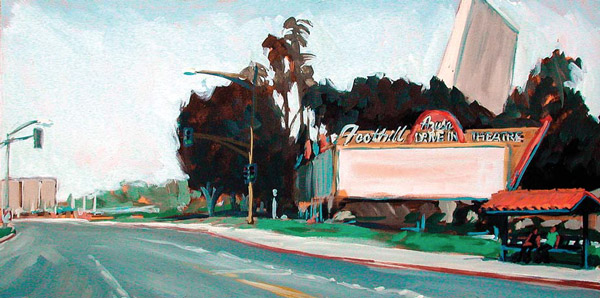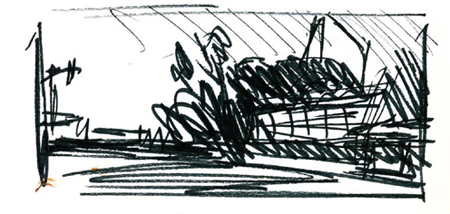
Azusa Drive-In
Acrylic on canvas (finished painting) 15" × 30" (38cm × 76cm)

Considered an originator of the contemporary mural movement in Los Angeles, Mortimer has painted nearly a hundred murals since 1971, several which have won community beautification awards. A freelance artist since 1969, Mortimer gave up his commercial art business in 1988 to focus on murals, paintings and drawings. His hometown of Long Beach, where he completed a 300-foot-long (91m) historical mural of the city, honored him as their Artist of the Year in 2004. In his plein air paintings, Mortimer is most interested in “the intersection between the man-made and the natural world.”

Azusa Drive-In
Acrylic on canvas (finished painting) 15" × 30" (38cm × 76cm)

My sketching is mostly done to work out composition and basic structure for my paintings. I look for dramatic or interesting subjects AND compositions. I use sketches to work out the basic structure of the composition and the arrangement of lights and darks.
I don't sketch daily or as a habit. I do it mostly when I want to visualize something for a project, whether a painting or a mural. It is a tool I use to get me where I want to go.
I usually sketch when I am on location, standing in front of my easel, and trying to decide how, exactly, am I going to set down what I see in front of me. We spend our lives experiencing the world in three dimensions, but in order to be able to communicate effectively in representational art, we have be able to express ourselves in two dimensions. So doing small, thumbnail-type sketches is a way to quickly try out various compositions and variations to help me decide how to do my painting. Sketching helps me learn to see the world in two dimensions.

Palisades Coast
Acrylic on canvas (finished painting) 15" × 30" (38cm × 76cm)

I prefer to sketch with a black Pentel Sign Pen on plain bond sketchbook paper — nothing fancy. The most important factor in a good composition is the basic arrangement of lights and darks, and working with a relatively wide, solid-black marker limits me to either solid black or solid white, with a little cross-hatching for gray areas. The Sign Pen is water-based, so it's easier to draw with (it doesn't soak into the paper very much). With these tools I am forced to simplify my composition in my mind in order to be able to express it in a small sketch with a relatively broad-tipped marker.
I deliberately do NOT try to do a beautiful sketch. The sketch is a tool to help me work out my composition, and I find that if I get caught up in trying to do a “good” sketch, I lose sight of my goal. And I lose the spontaneity and fluid strokes that are so important to help me express what I am experiencing. Sketching with fairly crude tools forces me to think in two dimensions and helps me to see what works and what doesn't work on the most basic compositional level.
I deliberately do NOT try to do a beautiful sketch. The sketch is a tool to help me work out my composition, and I find that if I get caught up in trying to do a“good” sketch, I lose sight of my goal.

The artist's first, rejected sketch of the scene.

His final sketch with a better composition.

California Incline
Acrylic on canvas (finished painting) 18" × 36" (46cm × 91cm)
When I am sketching, I think about the scene I am looking at and the painting I am going to create. And I think about how I can express my feelings and appreciation of the scene in front of me through my composition and communicate that to the viewer.
Sketching a scene before painting it helps me distill it to its essence and then figure out how to communicate that essence in my painting. When I look at a scene, preparing to sketch it with a black marker, I am forced to look for the most fundamental building blocks of my composition — the light areas, the dark areas — and see how they can work in my painting. I have learned so much about how we experience the world by having to deconstruct and simplify it for my work. I can then put it back together in a way that creates an interesting and meaningful experience for the viewer.

PCH Curve
Oil on canvas (finished painting) 12" × 16" (31cm × 41cm)

I feel blessed to be able to do this work — to paint, to draw, to experience the world through an artist's life and eyes. I feel the glory and beauty of the world we live in, no matter where I am and what I am going to paint. Doing a sketch of a scene I am going to paint helps me feel connected to the scene and be a part of it. And it helps me to feel more confident in the adventure I am about to embark on: my painting.
Working on small sketches with a fairly broad tip black marker makes it essential to try to express as much as possible with as little as possible. This opens the door for free, gestural strokes; a willingness to let simple lines and shapes express a lot; and practice at letting accidents happen and using them to one's advantage. There's no going back when sketching with a black marker.
